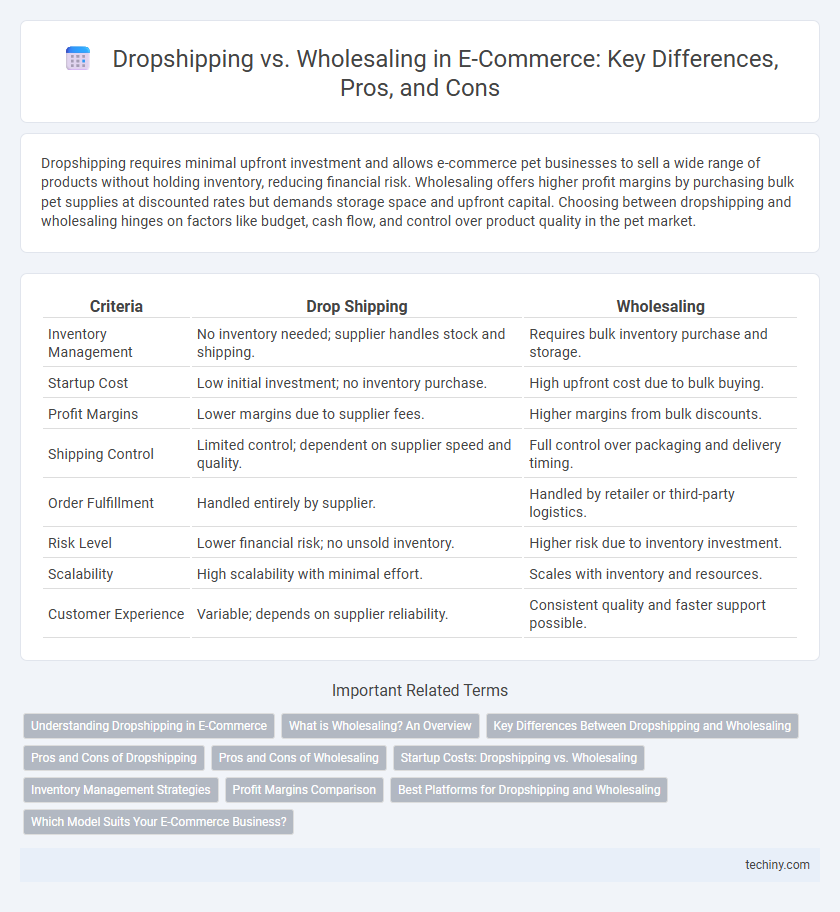Dropshipping requires minimal upfront investment and allows e-commerce pet businesses to sell a wide range of products without holding inventory, reducing financial risk. Wholesaling offers higher profit margins by purchasing bulk pet supplies at discounted rates but demands storage space and upfront capital. Choosing between dropshipping and wholesaling hinges on factors like budget, cash flow, and control over product quality in the pet market.
Table of Comparison
| Criteria | Drop Shipping | Wholesaling |
|---|---|---|
| Inventory Management | No inventory needed; supplier handles stock and shipping. | Requires bulk inventory purchase and storage. |
| Startup Cost | Low initial investment; no inventory purchase. | High upfront cost due to bulk buying. |
| Profit Margins | Lower margins due to supplier fees. | Higher margins from bulk discounts. |
| Shipping Control | Limited control; dependent on supplier speed and quality. | Full control over packaging and delivery timing. |
| Order Fulfillment | Handled entirely by supplier. | Handled by retailer or third-party logistics. |
| Risk Level | Lower financial risk; no unsold inventory. | Higher risk due to inventory investment. |
| Scalability | High scalability with minimal effort. | Scales with inventory and resources. |
| Customer Experience | Variable; depends on supplier reliability. | Consistent quality and faster support possible. |
Understanding Dropshipping in E-Commerce
Dropshipping in e-commerce allows retailers to sell products without holding inventory, relying on suppliers to ship directly to customers, minimizing upfront costs. This model reduces financial risk and inventory management challenges compared to wholesaling, which requires purchasing bulk stock and handling warehousing. Understanding dropshipping's reliance on supplier reliability and shipping times is critical for maintaining customer satisfaction and competitive advantage.
What is Wholesaling? An Overview
Wholesaling involves purchasing large quantities of products directly from manufacturers or distributors at a discounted rate and selling them in smaller quantities to retailers or end customers. This model requires upfront investment in inventory storage, order fulfillment, and inventory management, allowing control over product availability and pricing. Wholesalers benefit from bulk purchasing discounts and higher profit margins compared to drop shipping but face higher risks related to unsold stock and storage costs.
Key Differences Between Dropshipping and Wholesaling
Dropshipping allows sellers to list products without holding inventory, relying on suppliers to ship directly to customers, which reduces upfront costs but limits control over fulfillment and profit margins. Wholesaling requires bulk purchasing and inventory management, enabling higher profit margins and greater control over stock but demands significant capital investment and storage space. Understanding these core differences helps e-commerce businesses choose the right model based on cash flow, operational capacity, and growth strategy.
Pros and Cons of Dropshipping
Dropshipping requires minimal upfront investment and allows sellers to offer a wide product range without inventory management but often results in lower profit margins and less control over shipping times. It reduces risks related to unsold stock yet depends heavily on supplier reliability, which can impact customer satisfaction. Managing multiple suppliers can complicate order fulfillment and challenge brand consistency in a competitive e-commerce landscape.
Pros and Cons of Wholesaling
Wholesaling offers the advantage of bulk purchasing, resulting in lower per-unit costs and higher profit margins for e-commerce businesses, while enabling greater control over inventory and shipping processes. However, it requires significant upfront capital investment, storage space for inventory, and increased responsibility for order fulfillment and customer service. Unlike drop shipping, wholesaling demands more operational resources but allows for faster shipping times and improved brand control.
Startup Costs: Dropshipping vs. Wholesaling
Dropshipping requires minimal startup costs since products are shipped directly from suppliers, eliminating the need for inventory investment or warehouse space. Wholesaling demands significant upfront capital to purchase bulk inventory and manage storage, increasing initial financial risk. Entrepreneurs opting for dropshipping benefit from lower financial barriers, while wholesaling offers higher control at the expense of larger startup expenses.
Inventory Management Strategies
Dropshipping eliminates the need for inventory storage by allowing sellers to forward customer orders directly to suppliers, reducing overhead costs and minimizing stock risks. Wholesaling requires upfront investment in bulk inventory, demanding efficient warehouse management and accurate demand forecasting to avoid overstocking and stockouts. Effective inventory management in dropshipping relies on seamless supplier integration and real-time inventory updates, while wholesaling depends on logistics coordination and inventory turnover optimization.
Profit Margins Comparison
Dropshipping often yields lower profit margins, typically ranging from 10% to 30%, due to reliance on third-party suppliers and higher per-unit costs. Wholesaling allows retailers to purchase inventory in bulk at discounted rates, enabling profit margins that can exceed 40% depending on the product category. E-commerce businesses prioritizing profitability usually favor wholesaling to maximize margins, while dropshipping offers flexibility with minimal upfront investment.
Best Platforms for Dropshipping and Wholesaling
Shopify and Oberlo stand out as top platforms for dropshipping, offering seamless product integration and automated order fulfillment tailored for e-commerce entrepreneurs. For wholesaling, platforms like Alibaba and SaleHoo provide extensive supplier directories and bulk purchasing options essential for cost-effective inventory management. Leveraging these specialized platforms enhances scalability and operational efficiency in both dropshipping and wholesaling business models.
Which Model Suits Your E-Commerce Business?
Choosing between drop shipping and wholesaling depends on factors like initial investment, inventory management, and shipping control. Drop shipping minimizes upfront costs and inventory risks by relying on suppliers to fulfill orders directly, making it ideal for small startups or testing new markets. Wholesaling requires bulk purchasing and inventory storage but offers higher profit margins and more control over product quality and shipping, suiting established businesses aiming for brand consistency and scalability.
drop shipping vs wholesaling Infographic

 techiny.com
techiny.com